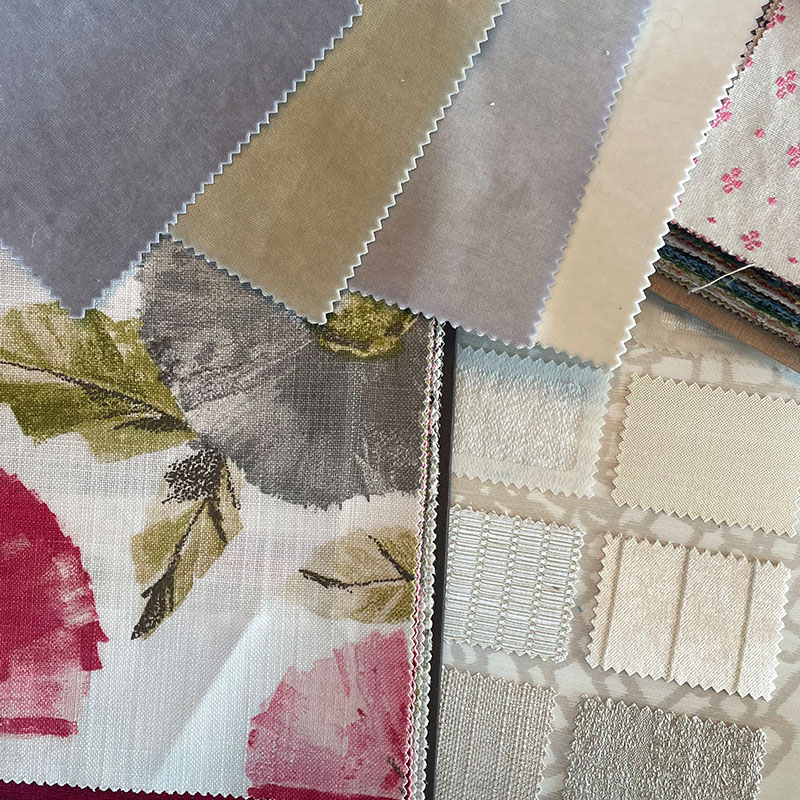The Importance in Choosing Your Fabrics - But Why?
Setting Fabric Goals for Functionality and Style

Before selecting your fabrics, it’s important to consider several factors. Striking a balance between your design vision, practicality, and budget is essential. Think about the overall design and how each element will complement each other . Remember each space serves a specific purpose, and one must understand how it will be used and by whom. Is it a casual family lounge, a formal dining area, or a playroom? For instance, a bedroom may call for soft, luxurious fabrics, while a TV room would benefit from more durable materials that can withstand everyday use.
While the range of fabric options can be overwhelming, it must be simplified by focusing on key factors such as visual appeal, functionality, and again budget limitations. Here are some common favorites to be considered.
Silk: Silk is an exquisite fabric that exudes elegance. Its beauty makes it a wonderful choice for formal settings, yet it is fragile and susceptible to damage. To maintain its charm, silk is best utilized in decorative applications such as curtains, wall art, or lampshades, as it lacks the resilience needed for high-usage. areas.
Leather: Leather, whether genuine or faux, is available in various textures, including hard, soft, and suede, making it an excellent choice for furniture and upholstery. Not only are these materials resilient and long-lasting, but they also bring a touch of sophistication to any space. Their versatility allows for a wide range of applications, from seating and tabletops to curtains, rugs, and cushions—truly, the possibilities are endless.
Rayon: If silk hasn’t been budgeted for yet you desire a luxurious look, rayon serves as a fantastic alternative. It closely resembles silk in appearance while offering greater durability, making it a great choice for both curtains and upholstery.
Cotton: Cotton is eco-friendly as a natural fiber, enhancing daily living with its durability, absorbency, breathability, softness, and ease of maintenance. It’s ideal for curtains, cushions, and bedding Additionally, it offers a vast range of colors and is more affordable than most other fabrics, making it an ideal choice for your home.
Polyester:Polyester blends are widely used in interior design for upholstery, cushions, and curtains, making it a practical choice for active households. These blends offer durability while maintaining the soft feel of cotton.
Velvet: Velvet is the ultimate choice for those seeking opulence, known for its exquisite texture that adds a sensual and luxurious atmosphere to any space. While its popularity may ebb and flow, velvet consistently infuses a room with sophistication.
Wool: Wool is an exceptionally versatile natural fiber known for its remarkable durability and warmth. Its woven form provides a level of resilience that makes it an excellent choice for carpets, throws, cushions, and upholstery, contributing to a cozy and inviting atmosphere. The diverse patterns and colours available in wool fabrics enhance various home designs beautifully.
Fabric Weights and their importance
When choosing fabrics for interior design, fabric weight is a crucial consideration. While texture, colour, and pattern are important, the wrong weight can lead to functional issues. Fabrics are classified by GSM (grams per square meter), with heavier fabrics generally being more durable.
Durability is also assessed through double rub tests, which measure wear resistance. For upholstery, aim for at least 15,000 double rubs for heavy use, while formal settings can work with fabrics around 9,000 double rubs. Here’s a quick guide:
- Delicate use: < 9,000
- Light use: 9,000 – 11,000
- Medium use: 12,000 – 15,000
- Heavy use: 15,000+
Understanding these factors makes sure you select the right fabrics for the right job.
Most manufacturers stop testing once fabrics reach 35,000 double rubs.
Samples, samples, samples, they are a must
Sampling is a critical to the design process. Without it, one would be working blind, lacking insight into how materials, colours, and textures will relate to the whole. Sampling allows for firsthand experience in touch, durability, ascetics, etc., enabling informed decisions before committing to the final decision.